Welcome to the world of clothing line photo shoots, where every photo you take is an opportunity to inspire your fashion brand. Picture this: You’re browsing your favorite fashion website, and what’s holding you back from scrolling? Beautiful fabric designs that practically scream ‘Add to cart!’
In this blog, we will walk through the entire process of creating these eye-catching, head-turning images when starting a clothing line with easy steps. From planning to the final camera click, we narrate how to make your clothing line pop in style. Because in the world of fashion, high-quality images aren’t just pretty – they’re the secret to your success. Say cheese, let’s get to it!
What Is A Fashion Photo Shoot For?
A fashion photoshoot is a chance to present a fresh clothing line to its intended audience, whether they are retailers or customers. The photographs must clearly show the precise features of the garments’ fabrics, designs, cuts, and finishes. Additionally, it aids in conveying to clients the idea behind the collection. The fashion shot needs to complement the collection’s goals, ideas, and messaging because of this.
7 Steps for Planning Your Clothing Line Photoshoot
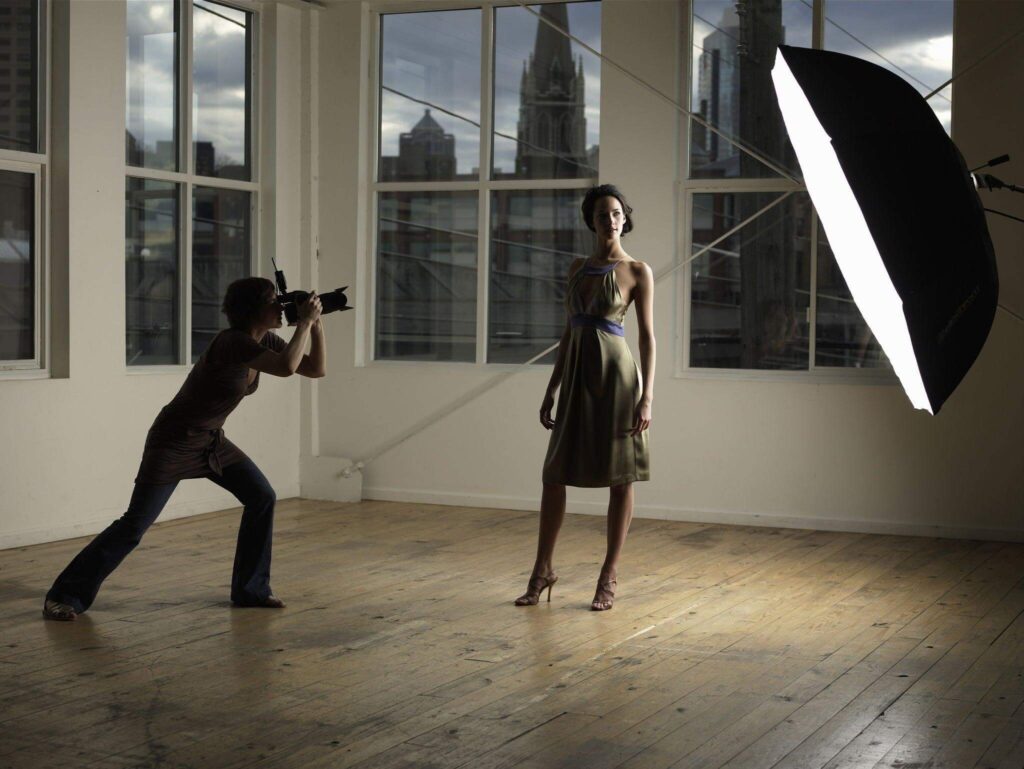
1. Prepare Your Clothing
In your photos, your objects should look outstanding. Unluckily, storage and transportation can cause garments to wrinkle, crease, and start to look worn. Clothing samples endure a particularly difficult life because they often travel great distances and may not have been made with ideal construction to begin with.
While preparing clothing for photography is an essential first step, many photographers omit this step in favor of using Photoshop or other free photo editing tools to remove wrinkles, stains, and other obvious flaws.
Avoid doing that. Photoshop isn’t magic; learning advanced editing techniques requires practice and knowledge, and overusing Photoshop runs with the risk of lowering image quality. Try to get your clothing as close to perfect as you can, and just use Photoshop to make minor adjustments and correct color.
2. Set up Your Photo Studio
To bring your unique clothing brand photoshoot ideas to life you can create a photographic studio in almost any room with a few simple tools. With a camera, tripod, white wall, C-stand, duct tape, and ambient light, you can get by. It’s worthwhile to spend a little extra money on a few additional pieces of equipment if you want more control over your shooting schedule and location.
Backdrop
To eliminate distractions in your photoshoot for a clothing line and to make sure you catch colors as precisely as possible, always choose a white or light grey backdrop. Seamless rolls of white paper are great for this purpose, are inexpensive, and are widely accessible at any photography supply store.
To avoid creases and distracting shadows, sweep the roll to the floor so that it is curled and secure it with tape. Your background placement options will be more flexible if you use a stand, giving you more room to move around the studio.
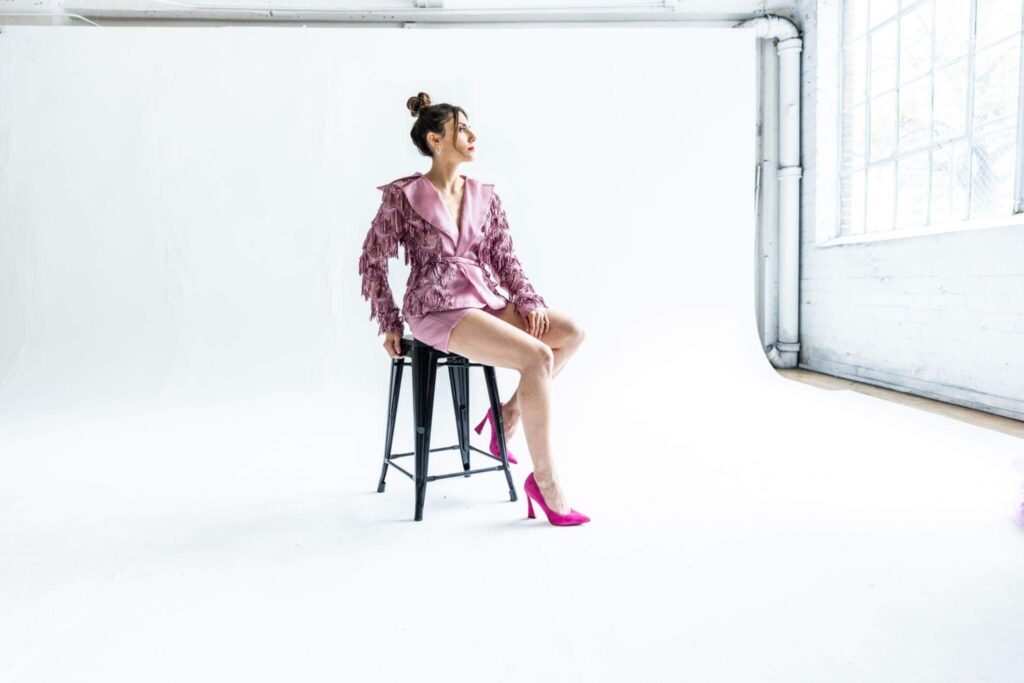
If your budget is tight, you can tape the seamless roll to the wall or the ceiling. Place a model or mannequin holding your products in the center of the background, right in front of the camera.
Camera
To shoot fashion photography, I advise utilizing a DSLR with manual exposure and aperture settings or a very affordable substitute that is immediately at your fingertips: your smartphone! Utilize a tripod. Your shots will be steady, which also gives you more time to utilize your hands for other activities.
Place your tripod and camera so that they are facing the object. Throughout the session, you won’t often move the camera. The product should be moved from various angles.
Lighting
A cheap and excellent light source for any photoshoot for a clothing brand is natural window light. Having a big window and lots of natural light is fantastic! It might be all you require. However, if you have the money, I strongly advise that you rent or buy a lighting kit that is simple to use.
When there isn’t enough light coming in via the window, you will still be able to shoot if you have access to artificial lighting equipment. The increased adaptability can significantly boost your productivity, and consistent lighting can help you present a polished image. You’ll need a light head, softbox, C-stand, battery pack, and pocket wizard for a single light setup.
You may consider the “light head” to be the light itself. I advise you to begin with a mono light, often known as a mono strobe light head. To diffuse light and photograph your products in an appealing and uniformly lighted manner, a softbox is required. The C-stand will support your light head and the softbox around it. By using a pocket wizard to sync your camera and the light, your light head will effectively become the camera’s flash.
3. Position Lighting
When using natural light for clothing photoshoots, place your product close to a window so that it can receive even, indirect lighting. If you’re utilizing a mono light setup, position the light source, softbox, or umbrella at a 45-degree angle to the product to ensure uniform, soft lighting throughout.
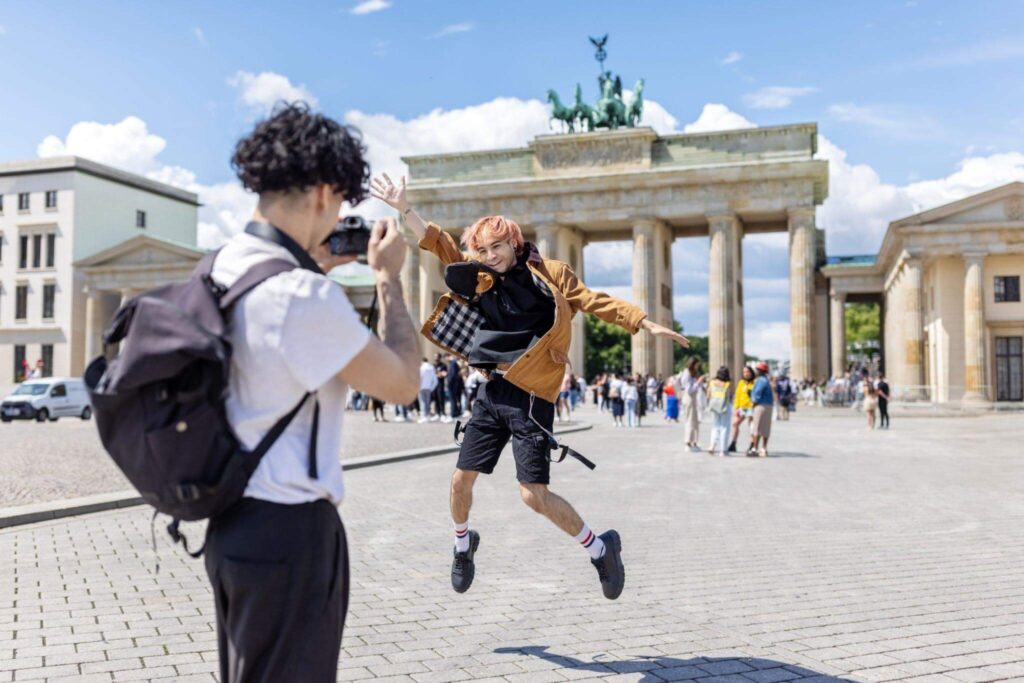
Keep your camera facing the subject directly. You can get some shadows if you position the products too close to the background. Simply move the product further away from the background if this occurs to have a crisp, white background. Reduce the power of your light source to around half.
The light meter on your camera can be found by looking through the viewfinder. To manually expose an image properly, you simply need to change the settings until the meter notches are at 0.
When utilizing a strobe, it is more difficult because the camera cannot detect any lights until the flash activates. Set your aperture to f-11 or higher and your shutter speed to 1/200 or less to get started. To acquire the best exposure and focus, you will then need to take test photographs and adjust your camera settings.
Spend some time charging in between flashes. If you shoot too quickly, your light source cannot turn on in time, depending on how powerful your battery pack is.
4. Styling
Mannequins
Mannequins are excellent for fashion shoot ideas because they are consistent, reasonably priced, and simple to operate. Spend some time styling your product on the mannequin. If your item appears to be too large, try pinning and tucking it closer to the mannequin until it is the right size.
Models
Although models are the most ideal since a real person’s body helps a customer relate to your products and exude professionalism, the procedure might be unpredictable. Fashion is brought to life by models, but they are very expensive.
Hanging Apparel
Products are displayed at eye level using hanging clothing. It is less expensive and quicker than the other methods discussed above. Clothing is hung on a hook and photographed while it is in front of a wall or on a white background. The hanging clothing shoot ideas are best for light fabrics, like silk. The garment won’t wrinkle after being prepped.
Flat Lay
A “flat lay” shot is taken from above while objects are placed on a flat surface. The term “bird’s-eye view” is also used. Instead of using mannequins or models, flat-lay fashion photography ideas are a fantastic alternative that can help you make stunning, profitable product images. It’s a method that’s frequently utilized for social media pictures. However, you can also utilize it for the content of your website.
5. Set Your Camera
Your fashion product shoot won’t seem professional, no matter how skilled you are at Photoshopping, if your camera settings are off. Before you photograph items, make sure you are familiar with ISO, aperture, and white balance.
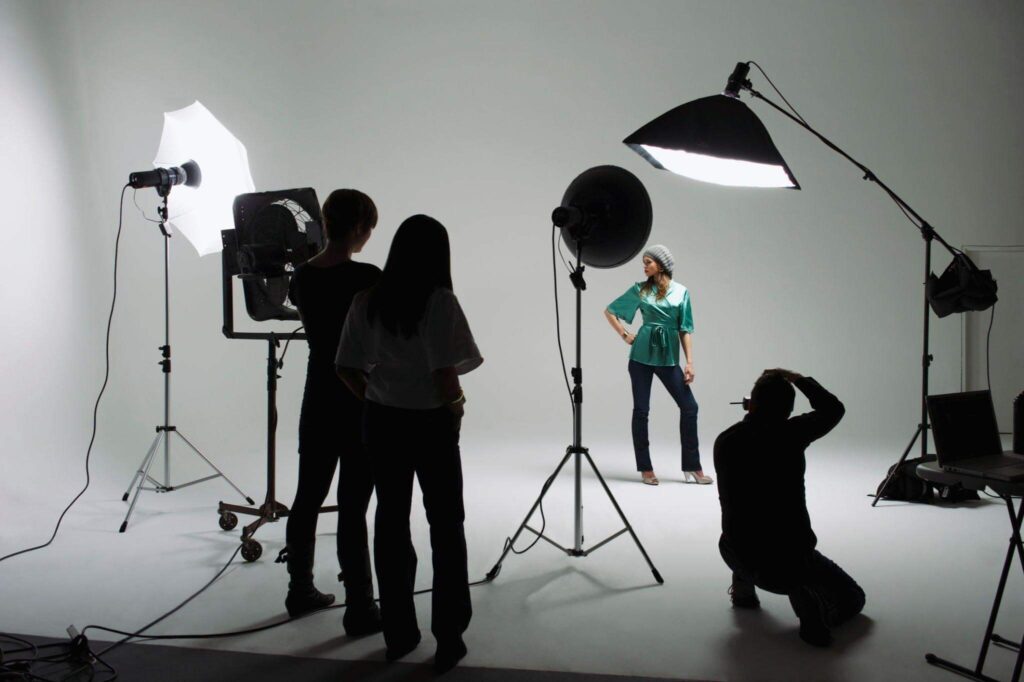
ISO
Make sure that your ISO is between 600 and 640. Higher ISOs cause distracting “noise” or “grain,” which are specks of color or gray that give images a more film-like appearance. Details start to appear mushy at higher ISOs since the camera can’t capture as much sharpness. You may maintain your ISO at 100 or 200 with a tripod for the best sharpness and clarity.
Aperture
Focus is controlled by the aperture, which is indicated by the f-number of your camera’s settings (for example, f-16, f-2.8). In general, more portions of the image will be in full focus as the aperture number increases. Make sure your aperture is adjusted higher than f-11 so that all of your products may be in sharp focus.
White Balance
The warmth of various light sources varies, resulting in what is referred to as a color cast, which makes it challenging for your camera to detect genuine white. How the camera interprets the colors it records depends on your white balance setting.
There are many various kinds of light sources, but tungsten, fluorescent, LED, and natural sunlight are the most popular ones for photoshoots of clothes. You may either set your white balance to Auto and allow the camera to make the decision, or you can adjust it, particularly for the sort of light source you’re using.
6. Take the Photo
The time has finally come for which you have been waiting! Point your camera at the subject, push the shutter release button halfway, wait for the subject to come into focus, and then take the picture. If you realize that your photographs require more or less light throughout the session, change the settings on your camera. As you practice, your adjustments will become instinctive.
During your photo session fashion, take as many pictures as you can. The front, rear, 45-degree angles, left and right sides, and any details could all need to be captured on camera. Try taking some close-up pictures to bring out any unique features in your clothing. The better, the more shots. If the product is supported by numerous images taken from various angles, customers will be able to trust their initial perceptions of it.
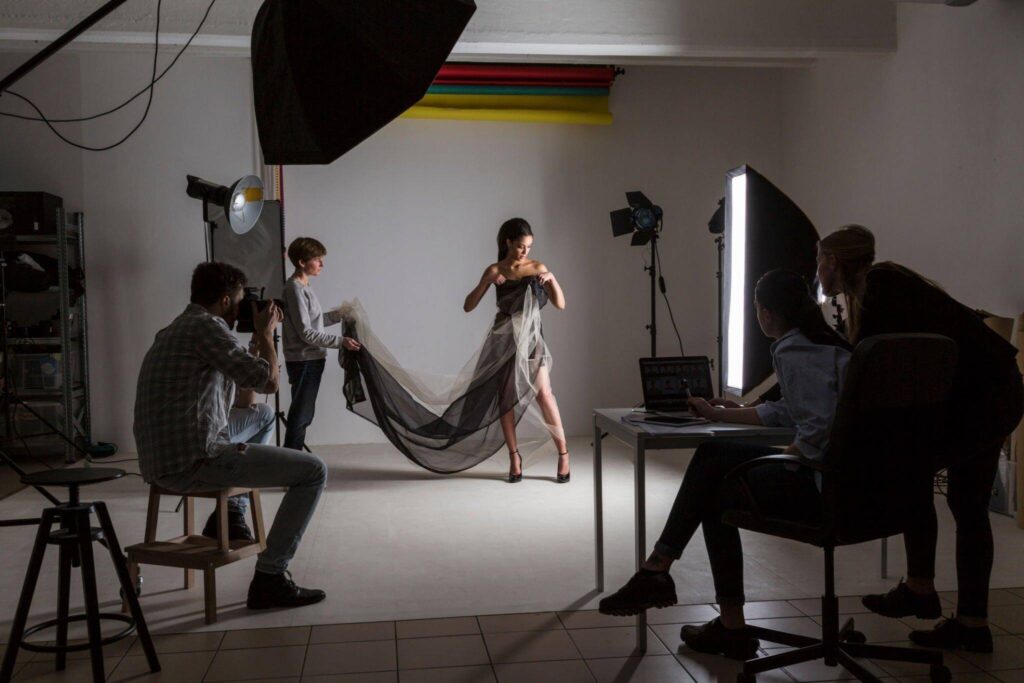
7. Finalize In Post
It’s time to get your clothing brand photoshoot ready for the web when you’ve finished shooting. Making your photographs look as professional as you can while keeping optimal functionality is the aim of post-production processing.
To retain a unified and expert image, make sure your post-production process and editing take alignment, cropping, background removal, and color correction into account. Keep track of your procedures so you can create a set of guidelines that are consistent for both shooting and editing.
Alignment
Ensure that all of your products are centered and the same size in each photograph. Your items’ angles, corners, and edges should all be parallel to one another. Making guidelines in a Photoshop template is the simplest approach to guarantee that your alignment is precise.
Cropping
Similar to alignment, when you’re considering photoshoot ideas for a clothing brand, you should crop product photographs uniformly to ensure a smooth online buying experience for your clients. If you follow alignment principles, cropping regularly and resizing photos to fit the requirements of your website shouldn’t be an issue.
Background
It is recommended to use a white background, which is advised and, in some cases, required by marketplaces. By removing the background, you may go one step further and remove potential sources of distraction. Getting rid of the background can provide you with more creative freedom when designing websites and slightly reduce file size.
Color
Some colors, such as neons, reds, and pinks, are challenging to picture accurately on camera, and frequently require editing in Photoshop, even with careful attention to white balance. When you want your fashion photoshoot ideas to shine out, take a few extra minutes to make sure that the colors of your clothing are right because poor color representation might irritate and upset clients.
The Unique Psychology of Clothing Line Photo Shoots

While the technical aspects of photoshoot fashion are important, understanding the psychology behind a successful image can set your brand apart. It’s not just about capturing the right image; it’s about evoking emotions and connecting with the audience. Here’s a sneak peek into the fashion concept and psychology:
Color Psychology
Colors evoke different emotions. For example, red represents passion and strength, while blue emphasizes confidence and calmness. When choosing backdrops, accessories, and clothing colors, consider the emotional response you want to evoke in your audience.
Model Body Language
Models play an important role in communicating emotions through body language. A subtle smile, confident posture, or playfulness can all influence how your audience perceives your style. Make sure your models understand the emotional message you want to convey.
Storytelling
Every piece of clothing has a story. Whether it’s about sustainability, empowerment, or classic beauty, your images need to tell that story. Use props, settings, and poses to align your images with your brand story.
Consumer Empowerment
Today’s consumers want to see themselves in your product. The best clothing line photoshoot idea will be the use of inclusive modeling to show that your fashion caters to people of all shapes, sizes, and backgrounds. When customers see that you represent them, they feel empowered and are more likely to connect with your brand.
Authenticity
Authenticity is key in the age of social media. Avoid over-editing or airbrushing your images. Embrace flaws and natural beauty. Your audience is more likely to trust a brand that makes it real.
How Much Does A Clothing Line Photoshoot Cost?

The total cost of a high fashion photoshoot can differ significantly based on a variety of variables, including the location of the shoot, the photographer’s experience, the number of garments being taken, and any optional services (such as hair and makeup, retouching, or equipment).
Photographer Rates
Before hiring a photographer, ensure you do proper research. Do not get fooled by photographers who have zero skills. If you want to showcase your brand’s new cloth articles and sell them, you must hire a professional photographer who knows all the angles. Typically, the cost of photographers varies from $100 – $300 per hour.
Location and Set
The cost of a photo shoot can be considerably influenced by its location. Outdoor spaces like a beach or park are frequently free to use. However, permits could be necessary. Depending on the location and size, indoor sites, such as a studio or rented space, might cost a lot of money.
Shooting in a studio can be more expensive than photographing outdoors. Depending on the location and amenities provided, studio rentals can cost anywhere from a few hundred dollars to several thousand dollars ($300 – $2000).
There may be extra expenses associated with shooting in a more far-flung or exotic location, such as travel, hotel, and transportation fees for the photographic crew and the models. Overall, when creating a budget for a photo shoot, venue costs might be very important. Before making a choice, it is recommended to ask the location management how much the rental or permit would cost.
Props
A prop helps the photographer and model feel good throughout the entire shoot by helping to envision the message or concept. It also makes the main subject stand out, accentuates the makeup and features, and gives a scene depth.
Different kinds of props are possible, including flowers, prism glasses, candles, fairy lights, colored cards, confetti, etc. These accessories enhance your offering. A prop typically costs $50 to $120, depending on your needs.
Backdrop
To eliminate distractions and make sure you catch colors as faithfully as possible, always choose a white or light gray backdrop. The best photoshoot idea for a clothing line, inexpensive and easily accessible at any photography supply store, is seamless rolls of white paper. Purchase a backdrop lighting kit for about $100 if you have one.
Model Photo Shoot Cost
Depending on the style of shoot, the expertise and reputation of the models, as well as the length of the session, the cost of models might vary significantly. Models are frequently compensated for their time in commercial photo shoots. Models might cost anywhere from $200 to $300 per hour, depending on their reputation and level of experience.
While more seasoned or well-known models can fetch significantly higher costs, new models or those with less experience may have lower costs. The price varies depending on how the images will be used, such as if they will be used for editorial, advertising, or e-commerce. Instead of money, models may occasionally receive trades in the form of clothing or other products.
Pro Tip: To avoid misunderstandings, it is crucial to discuss the compensation package with the models and their representatives before the shoot.
Hair and Makeup
Given the type of shoot, including high fashion photoshoot ideas, the experience and reputation of the hair and makeup artist, and the number of looks or costumes being photographed, the rate of hair and makeup for a photoshoot may change for basic hair and makeup, even with a budget of $200.
Overall, when creating a budget for a high fashion photoshoot, the cost of hair and cosmetics can be a crucial component. Obtain quotations from several hair and makeup professionals to obtain an idea of the price for the particular requirements of your photo session.
Concluding Your Journey to Perfect Clothing Line Photos
Photographing your clothes is your gateway to leaving a lasting impression in the fashion world. By mastering the art of planning, setting up your studio, perfecting your images, and paying attention to the finer details, you are well on your way to capturing the essence of your brand.
Remember, it’s not just about the clothes; It’s about the emotions, the stories, and the connections your images create. So, grab your camera, gather your team, and let your clotheslines shine with the power of high-quality, professional photography. Happy shooting!
Also, now take the next step in your fashion journey –uncover the strategies of how to add your brand in stores, and let’s make your brand a retail success.







